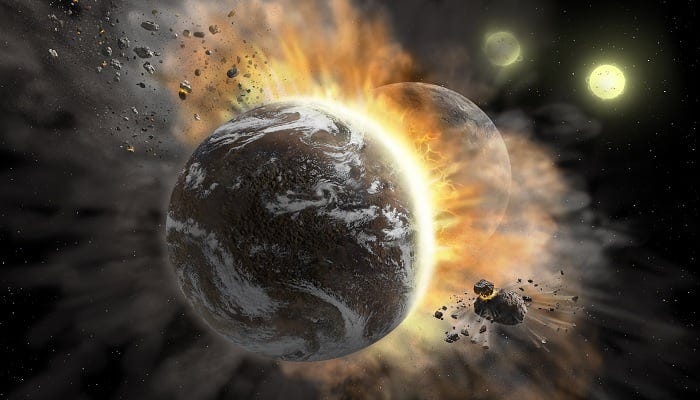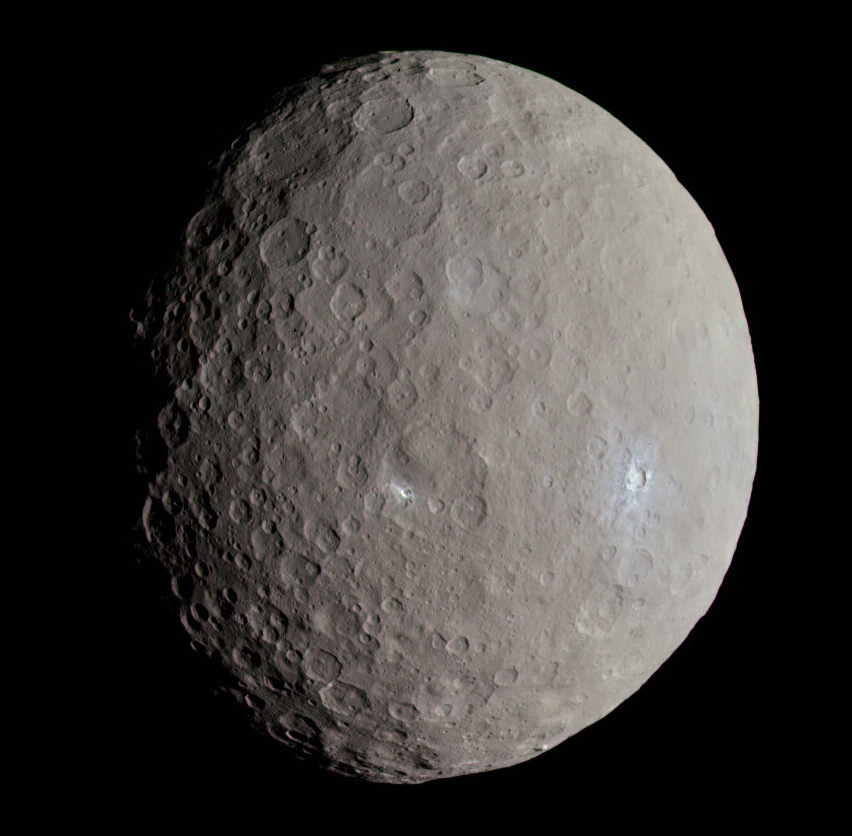Are We Cosmic Refugees? The Hidden Story of Tiamat, Earth, and the Asteroid Belt
From Sumerian myths to NASA discoveries—why Earth might be the orphan of a forgotten world

According to the Sumerians, another planet was present in our solar system. What is the strong evidence that supports this?
The Sumerians say that, in the beginning, as our solar system was forming itself, there was a planet called Tiamat, which was a large planet forming. Bode’s Law says where a planet should be positioned. This law accurately predicted the existence of a planet between Mars and Jupiter, which led to the discovery of Ceres and the Asteroid Belt. It also predicted Uranus’s orbit fairly well before its discovery in 1781. Neptune and Pluto do not fit the pattern well, undermining its credibility as a physical law. Bode’s Law is not a fundamental physical law, in the sense of Newton's Law of Gravitation, which dictates how bodies must behave. Instead, it's an empirical rule, a mathematical curiosity or pattern that happened to describe the approximate distances of the planets known in the 18th century, surprisingly well. It raises interesting questions about whether planetary spacing arises from resonant or harmonic principles, but its predictive power remains limited.
where m would be -∞, 0, 1, 2, 3, 4, 5... for Mercury, Venus, Earth, Mars, Ceres, Jupiter, Saturn…
Unlike the traditional Bode’s Law, which uses a simple doubling rule to estimate planetary distances, Richardson proposed a more refined and accurate approach. He suggested that the distances of planets and satellites adhere to a two-part rule: first, each orbit is spaced according to an exponential progression based on the factor (1.728)^n, where n is the body's position in sequence. Then, this base distance is fine-tuned by a correction factor ρ_n, which adjusts for subtle variations in orbital spacing. This correction factor is derived from a unique “distribution ellipse” associated with each system, such as the solar system or Jupiter’s moons, where the angular position (4π/13)n determines the exact adjustment needed. By combining geometric growth with system-specific symmetry, Richardson’s model achieved a much closer fit to observed data than Bode’s Law, often within less than 1% error.
The Core Formula is:
where R_n is the distance to planet/satellite n, and n is the ordinal number of the planet or satellite in its system (e.g., Mercury=1, Venus=2, or starting from 0), and the value of ρ_n for a given body n is the radial distance on this distribution ellipse at an angle θ_n=(4π/13)*n.
Below is an abstract PDF of his work for further details:
Richardson's formulation accounted for a body/region at ordinal number 5 between Mars and Jupiter (2.866 AU), which Bode's Law predicted (2.8 AU). Science is fundamentally clear about the possibility of a planet that could have existed between Mars and Jupiter in the formation of our solar system, which is the position of the asteroid belt. So what happened?
An interview from Robert Sepehr with the American author and paranormal researcher Loyd Pye on human origins, the Anunnaki, Planet X, and Nibiru offers intriguing insights and possible answers (Source of the full video).
Our solar system isn’t just a neat arrangement of planets, it’s a mystery wrapped in ancient stories, many of which we’re still piecing together. The Sumerians, thousands of years ago, carved tales of celestial dramas into their clay tablets, speaking of gods and wandering stars. But how much of it was myth, and how much was memory? We may never know for sure, but one theory feels almost like a cosmic detective story: What if there was once another planet, Tiamat, floating where the asteroid belt now drifts between Mars and Jupiter?
Some researchers and mythologists wonder if Tiamat, a world possibly rich with oceans, was shattered long ago in a catastrophic collision, leaving behind broken fragments. And here’s the wild part: Earth itself might be one of those fragments, a kind of orphaned child of that lost world. If that’s true, does that make us descendants of cosmic survivors? Refugees from a planet that no longer exists?
Then there’s Ceres, the dwarf planet hiding in the asteroid belt. It’s not just another space rock; it’s packed with water ice and might even have a hidden underground ocean. Could Ceres be another piece of Tiamat, a frozen remnant of that ancient disaster? The idea gets even more fascinating when you consider that water, and maybe even the ingredients for life, could have been scattered across the solar system by that explosion.
Of course, not every scientist agrees. Astronomy prefers hard evidence over ancient myths. But isn’t it thrilling to think that our home planet’s story might be written in stardust and echoes of a forgotten world? Whether fact or legend, the tale of Tiamat reminds us that the universe is stranger and more poetic than we often imagine.
Let me tell you something wild—the more we look into this Tiamat story, the more it feels like we're uncovering an ancient secret we were never supposed to forget. We know how the asteroid belt seems like it's just floating space rubble. Well, astronomers have this nagging feeling, there's not enough stuff out there for a proper planet. But what if that's because there was one, and it's just... gone?
The Sumerians weren't just making up bedtime stories. Their "Enuma Elish" poem describes Tiamat as this cosmic mother of the deep, torn apart in some divine battle. And here's the thing: what if that wasn't just mythology? What if it was their way of describing something real, something terrifying that happened right over our heads?
Modern scientists running simulations keep finding that our early solar system was a demolition derby. Planets weren't just peacefully orbiting; they were slingshotting around, crashing into each other. Some think Jupiter might have yeeted a whole Neptune-sized planet straight toward where Tiamat would've been.
Now, hold on, because the Sumerians talked about exactly this. They called it Nibiru, a "rogue planet" that messed up the heavens. And here’s the kicker: when NASA’s Dawn probe reached Ceres, it found bright, salty stains, exactly what you’d get if an ocean world got blown to pieces. Those white spots? They might be Tiamat’s last tears, frozen in space.
This is where it gets personal. What if the water in your glass right now wasn’t always Earth’s? When Tiamat exploded, its shattered pieces might have bombarded our young planet during what scientists call the Late Heavy Bombardment. We’ve found space rocks with water molecules that match ours perfectly. So, yeah, you might be sipping on alien sea remnants.
And that’s not all. The moon? Some think the same disaster that killed Tiamat might have set off the collision that created it. So when you stare up at the night sky, you’re looking at a monument to cosmic destruction and survival.
Here’s the real mind-bender: you are proof that this might be true. The iron in your blood? Forged in dying stars. The water in your cells? Could’ve once flowed on Tiamat. Every time you sweat, cry, or take a breath, you’re recycling atoms that have already lived through the end of a world.
Think about astronauts passing through the asteroid belt. They’re not just floating through rocks, they might be drifting through the graveyard of our planetary ancestor.
The Sumerians didn’t just write this down as history, they were aware of it happening again. Their texts warn that Nibiru might return, that the destroyer could come back. Scientists roll their eyes at "Planet X" theories, but here’s the creepy part: we have found rogue planets drifting alone in the dark between stars. The universe does repeat itself.
But here’s the beautiful part: if we’re the children of catastrophe, then we’re proof that destruction doesn’t always mean the end. It can mean rebirth. Every atom in you has already survived apocalypses. You’re made of the stuff that outlasted worlds.
That’s not just science, that’s the oldest story humans have ever told. And whether it’s written in clay or stardust, it’s our story.
So, what do you think? Are we the orphans of a lost planet? The universe’s way of remembering something that once was? Or is it all just a crazy coincidence? Either way, next time you look up at the night sky, remember that what you are viewing could be from your family’s past... and their mark on the stars.






How dearly wounded we have all become not to see the face of Otherness as our One as well! Spared Humanity will meet again in these times (it was foretold), although never with completion, and only within a narrow band of possibility co-created jointly in Time and Space as comforting mirrors. As One, we would truly know ourselves in embodiment was the Original Plan (I smile to myself at the memory now!). Only just realizing in hindsight (if never in temporal completion), that a more perfect vision comes back to the heart again later. The lingering amnesia you mentioned in your reply seems to be receding, the old veils lifting off gently and creatively for many of us now. as we tap back into who we were, are, and (hopefully) will be again. Thank you for your words of Activation here and now within the Blue Imprint of our Quantum recall!
The image of an archaic dying Swan comes to mind upon retelling of the old stories from Gilgamesh. Should we allow ourselves to postulate our fate in advance of any collapse or intentional-directed denouement? It seems likely that we are destined to transcend our Earth story in advance of any actual leave-taking. Chagrined not to have the knowledge to prove or disprove anything conclusively. The poetic transduction of verisimilitudes aborning here and now is intentionally incomplete. We will never know unless we ask. Who are we now? Whoever knows such may now answer.